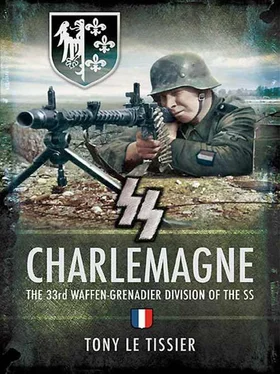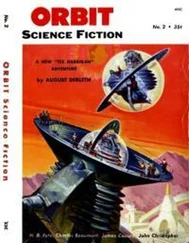Many of the legionaries, some of whom had once been militants in the Communist Party and had followed Jacques Doriot when he broke away from it, agreed that it was preferable to take up the anti-Bolshevik fight openly as a soldier on the Russian steppes rather than on French territory against other Frenchmen, most of whom were as mistaken in their views as they themselves had been.
The remnants of the LVF and the SS-Sturmbrigade provided about 1,200 men each for the Charlemagne .
The Miliciens similarly regarded themselves as belonging to the National Revolution and loyal to the Marshal, but reproached the legionaires for having adopted German uniform and for deserting their primary duty to France. By this they meant directly combating those terrorists and guerrillas operating under communist direction in France, a task they primarily regarded as an interior matter to be settled among Frenchmen, and not one to be left to the German army of occupation.
On the subject of Franco-German relations, the Miliciens were animated by the same sentiments as the members of the LVF and their patriotism was certainly no less. At the same time it was their political origin that led them to regard the fight on French soil against the communist-led Francs-Tireurs et Partisans as far more important than that against the guerrillas of the Secret Army (l’Armée Secréte) .
They did not have to be told of the importance of the fight on the Eastern Front and it should be noted that the original French members of the Waffen-SS were former Miliciens , a point that many members of the Charlemagne Brigade forgot when accusing them of being latecomers!
The 1,500 volunteers coming from the German Navy had little in common with the others save taking orders in German. For the rest, they were far less idealistic than any in the other formations.
There were also about 1,000 volunteers each from the NSKK (National Socialist Transportation Corps) and the Organisation Todt construction corps.
The invasion of France by the Western Allies dried up the source of new volunteers, condemning the various units already in existence to a more or less rapid but certain thinning out. But a major French formation was to remain on the anti-Bolshevist front right until the end of the conflict.
The French Waffen-SS was to produce a new type of combatant, young and fanatical, most of whom, not having served in any other army, could be typified as the ‘European Soldier’. They were like brothers to the other European soldiers of the Waffen-SS. They were no longer just Frenchmen, as the others were no longer just Danes, Letts, Germans or Belgians. More amenable than the older men to German military instruction, they were commanded in German, manoeuvred in German and sang in German, all things appearing somewhat scandalous to the Brigade’s original volunteers, but was this not the common language of the Axis forces in the European Army? Their symbol was no longer the Tricolore or the war flag with the swastika of the Greater German Reich, but the black flag with white runes of the Waffen-SS.
The founding of a large combat-ready unit with this variety of components posed some difficult problems for SS-Major-General Krukenberg and Waffen-Oberführer Puaud to resolve. But the fusion of these elements under the Waffen-SS cloak, which was at that time the subject of an incredible number of reservations, scruples or criticisms by the parties concerned, appears to have been the only practical and sustainable solution. In 1944 the Waffen-SS was, much more than the strictly German Wehrmacht, the true upholder of the European concept, and the only place for non-German Eurpeans was in its ranks.
Krukenberg was fortunate to have SS-Standartenführer (Colonel) Walter Zimmermann as the officer responsible for training. Born on 1 October 1897 at Meissen in Saxony, and a former member of the ‘Black Reichswehr’, Zimmermann had joined the new Wehrmacht in 1935, from where he transferred to an engineer battalion of the Waffen-SS at Dresden. He too had been attached to the Vth SS-Mountain Corps, in which he had served as Chief of Engineers. He soon became the most popular of the German officers through his tact and knowledge of Parisian slang. His capacities were stretched even further and he was to prove himself in Pomerania.
The Inspectorate headquarters, completely German, supervised the Brigade’s headquarters, which was entirely French, until it became the Divisional headquarters at the front in February 1945.
At first the Brigade at Wildflecken was commanded as follows:
Brigade: W-Oberführer (Brigadier) Puaud (LVF)
57th Regt: Major Gamory-Dubourdeau (SS)
58th Regt: Major Bridoux (LVF)
Heavy Bn: Captain de Vaugelas (Milice)
Soon after their arrival at Wildflecken, as a result of their French Army qualifications the senior Milice Française officers obtained the main command posts within the Brigade. There was considerable upheaval among the officers at this stage, and during February 1945. A total of fifteen officers, including Lieutenant Coutray, a friend of Darnard, were returned to France for various reasons.
To everyone’s surprise Major Bridoux suddenly resigned and left the Brigade at the beginning of December 1944 following a visit by his father, General Bridoux, the Vichy Minister of War. Before leaving, he tried to encourage other officers to follow his example. His departure suited Brigadier Puaud, who saw him as a potential rival for command of the Charlemagne , and tried to camouflage Major Bridoux’s departure as leave. Indeed, some of the Waffen-SS liaison staff would have liked to have seen Bridoux in command. His upright character had not only made him many friends, but he was held in high esteem by the Germans, to whom he would recite extracts from Hindenburg’s memoirs.
Then Major Paul-Marie Gamory-Dubourdeau, a former lieutenant-colonel in the French Army, was posted to the SS Main Office to head the French Department under SS-General Berger, and the two vacant regimental commands were taken over by Captains Victor de Bourmont and Emile Raybaud.
De Bourmont, a captain serving with the Tirailleurs Algériens , a prisoner of war released after volunteering for service in Syria, but too late for action, had then commanded the Milice in Lyon. Straightforward, reasonable and well-loved by his men, he was given command of the 57th Regiment of former SS men but, in contrast to de Vaugelas, Raybaud and Boudet-Gheusi, was not promoted Major until going to the front.
Raybaud, born in 1910, formerly an officer with the Chasseurs Alpins , who had served with the Milice at Limousin, a particularly devoted and courageous officer, was given command of the 58th Regiment of former LVF personnel.
Captain Jean de Vaugelas, born in 1915, a French Air Force captain in 1940, commander of the 2nd Cohort of the Milice at Glières in the Limousin, became Brigade chief-of-staff.
Captain Monneuse, former chief of the 5th Cohort of the Milice at Dijon, a 50-year-old of little military appearance, but patriotic, honest and courageous and with a good military grounding, was given command of the 1st Battalion of the 58th.
Then the Milice officers Captain de Bourmont and Bassompierre (an earlier transfer from the LVF to the Milice) were sent on a battalion commanders’ course. In all the Miliciens received a good number of command posts, in particular that of Captain de Vaugelas as chief-of-staff to the Brigade.
During the harsh winter of 1944–1945, while the grenadiers trained under the difficult conditions imposed by the cold, snow, sparse rations and lack of clothing and equipment, the future specialists were trained at the Waffen-SS special military schools.
Читать дальше












